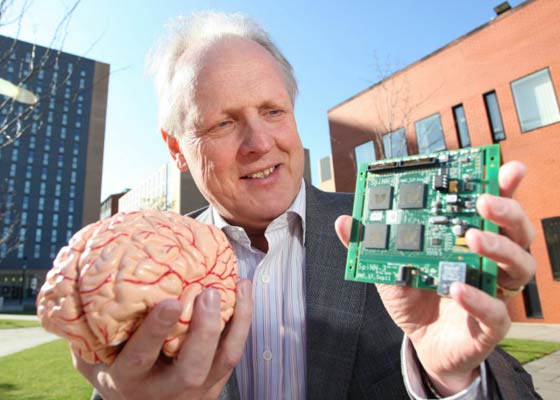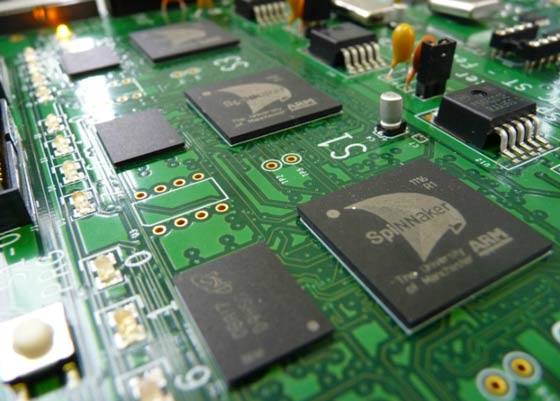Scientists at the University of Manchester are working on a project that aims to make a computer that can mimic the brain. The project is led by Professor Steve Furber who was one of the principal designers behind the BBC Micro and also worked on developing the ubiquitous ARM microprocessor.
The project to model the human brain is called SpiNNaker (Spiking Neural Network Architecture). In an abstract detailing the goal of the SpiNNaker project it says; “SpiNNaker is a million-core computing engine whose flagship goal is to be able to simulate the behaviour of aggregates of up to a billion neurons in real time. It consists of an array of ARM9 cores, communicating via packets carried by a custom interconnect fabric.”

Steve Furber with a brain and a circuit board. Photo from HumansInvent.com
Steve Furber talks about the SpiNNaker project to HumansInvent.com and details how long he has been working on the project “It’s a massively parallel computing machine that is a result of thinking about the issue of how to model brain-like functions. This is something I’ve been thinking about since 1998 and actually building since 2005”. Prof Furber says the SpiNNaker computer uses a concept called parallel computing. However this new system is different to previous parallel super computer systems. “In parallel super computers the messages are individually routed so each time you send a message you have to tell it where it has got to go whereas with SpiNNaker you effectively analyse the problem you are trying to model in terms of a set of processes and a graph that connects them together. The graph is effectively mapped into hardware in terms of routing so that when a processor that’s modelling a neuron wants to issue a spike all that processor has to do is drop a packet identifying the neuron that just spiked into the communications fabric and the fabric will then do all the routing.”
Currently the research team have a prototype which is a single circuit board containing 864 processors. There have been no significant setbacks, so the prototype will form the foundation upon which to scale up to a machine with a million ARM cores. Prof Furber notes that “even with a million ARM cores we are only at about 1% of the complexity of the human brain.” The research team also work with biological brain specialists to help them identify how to test the SpiNNaker machine meaningfully.

SpiNNaker prototype circuit board. Photo from HumansInvent.com
While the SpiNNaker project aim is to understand the human brain it is foreseen that the speedy simultaneous information processing technology garnered from the project could be useful in more mainstream computation tasks, including within the PCs of the future. We wrote about a similar brainy subject a fortnight ago when Google’s 16,000 CPU neural network was in the news, modelling how the brain recognises faces (and cats) with machine learning technology.














